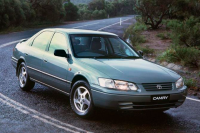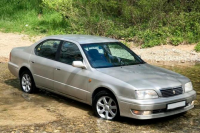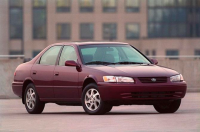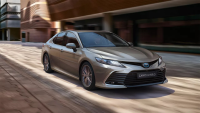The 1997 Toyota Camry passenger car was equipped with the bodywork of the then new generation XV20. The car was actively marketed in Australia, Oceania and North America, but is hardly ever seen in EU . Simultaneously, Japanese buyers offered generation V40 Vista, differing by body size and engine list. Vehicles with used vehicles in large quantities were imported to Europe through customs terminals in Vladivostok and ports on Sakhalin island.
Toyota Camry 1997 can be called one of the best cars.

A brief description of the 1997 Toyota Camry
The cars were equipped with a 4-door sedan body designed to carry 5 passengers. The XV20 was available in Europe and North America with front-wheel drive, and the G-Four with a four-wheel drive system with viscous clutch was available for Japanese customers.
The Vista variant was available with sedan or hardtop bodies (sold only through Toyota Vista Store). It differed from the XV20 by having a body in a smaller size than the XV20, which was tax deductible under Japanese legislation.
Features and specifications
The V40 had McPherson strut front suspension with anti-roll bar, and rubber wishbone rear hubs. The brakes were hydraulic, with ventilated discs with floating brackets at the front and drums (with automatic clearance adjustment) or discs in the rear. Power steering was rack and pinion type, for an extra fee the factory offered 4WS (4 Wheel Steering) to improve maneuverability.
Read also: 2013 Toyota Venza (Toyota Venza) video review and test drive
The base model had electric side windows and instrument cluster with arrow indicators. Improved models used Optitron combination with improved illumination of the scales. The steering wheel was made of polyurethane, and there were cars with a rim with wooden inserts on top and bottom. Some trucks had an electrically operated glass sunroof. Radio and CD player or navigation system with colour touch screen display were installed.
Specification
The 1997 Toyota Camry was equipped with stabilizer bar front suspension.
The ventilation and heating system had separate air ducts that delivered airflow to passengers in the rear row of seats. An air ioniser located in the air deflector in front of the driver's seat was used. The manufacturer offered electrically adjustable front seats with memory position.
The door trim depended on the material used for the seat upholstery, and there were bottle pockets in the front overlays.
Technical parameters of the car generation V40 (front-wheel drive model with 2.2L engine, 1997 model year):
curb weight - 1450 kg;
allowable full weight - 1725 kg;
average fuel consumption (by Japanese standard) - 10.2 km per 1 liter of fuel
body length - 4800 mm
width - 1785 mm
height - 1420 mm
wheelbase - 2670 mm;
ground clearance - 145 mm.
What difficulties modern owners will face
No matter how good and reliable the car is, time will take its toll. Today, looking at the photos, these cars already seem old-fashioned, with relatively square and rectilinear forms. Aesthetics are the exterior and the first downside of the car now. The car lacks many of the electronic auxiliary features that modern instances are equipped with.

When buying a trimmed 2000 Toyota Camry, for instance, the new owner will be faced with the need to replace virtually the entire suspension. One should pay attention to water pump, which tends to loosen after 2-3 years of exploitation in these versions.
Japanese producers have not in vain given a six-year warranty for metal corrosion, because till that moment the body really preserved its luster. However, 15-year-old cars may already start having rust problems.
Advantages and disadvantages
Advantages of the car, noted by the owners:
long life of the engine piston group (some instances have passed more than 600 thousand km without overhaul);
high quality of plastic and coating on decorative inserts;
roomy luggage compartment with the possibility to increase the capacity by partial or full folding of the back sofa;
wishbone suspension does not transmit vibrations and shocks when driving on rough roads;
availability of cheap spare parts from alternative suppliers (parts of inferior quality to original products).
Advantages
The car is of high quality and the availability of cheap spare parts.
The disadvantages indicated in the reviews and reviews are:
long engine piston group life (some models have gone over 600,000 km without overhaul);
high quality plastics and coatings on decorative inserts;
spacious luggage compartment with the possibility to increase the capacity by partially or fully folding the rear sofa;
wishbone suspension does not transmit vibrations and shocks when driving on rough roads;
availability of cheap spare parts from alternative suppliers (parts of inferior quality to original products).
Advantages
The car is of high quality and the availability of cheap spare parts.
The disadvantages indicated in the reviews and reviews are:
The age of the car, negatively affecting the condition of the bodywork;
Increased fuel consumption due to the use of outdated automatic 4-speed transmission;
difficulty in procuring new genuine parts;
large turning radius, making manoeuvring in tight spaces difficult;
cracked windscreens due to localised overheating from a heater (a problem in northern regions)
engine oil leaks at the joints due to natural ageing of seals and gaskets (after overhaul the defect disappears).
Vehicle equipment
The most popular Toyota Camry until 2001 was available as a four-door sedan. It had two powertrains and three options:
2.2L on manual transmission;
2.2 litre with automatic transmission;
3.0 litre with automatic transmission.
"The manual was a five-speed manual and the automatic was a four-band. Younger engines developed 131 hp, and the elder brother gave 190 "horses".
In terms of dimensions the car fit the standard of a family sedan for 1996. The length of the car was almost five meters (4760 mm). Width was just under 2 meters (1780 mm). The height was in the usual and comfortable range (1430 mm). Despite its size, it weighed not more than 1.5 tons (1400 kg), with a maximum permissible curb weight of 1500 kg.
The braking system was different, with drum brakes at the rear and disc brakes at the front. The fuel tank holds no more than 70 litres. It took 11.7 seconds for the 1996 Toyota Camry to reach a hundred kilometres per hour.
The 2001 Toyota Camry and newer models were described as having a maximum fuel consumption of 7.4 litres per gallon. In the city this figure reached 13.5 litres, and in the mixed cycle 9.6 litres.
Safety Camry
In the second half of the 1990s, driver and passenger safety requirements continued to tighten. Inflatable airbags for the driver and front passenger were fitted as standard, and side-impact protection was provided by an alloy steel body cage. The braking system had an ABS unit which automatically distributed the forces between the wheels. Inertia type seat belts with pyrotechnic tensioners and height adjustment were fitted for driver and passenger.
Rear row was fitted with non-adjustable inertia belts for 3 passengers with mountings for an additional child seat. To provide fire protection the fuel tank was stowed in a recess under the rear sofa (inside the wheelbase). The tank capacity on front-wheel drive vehicles was 70 litres, on all-wheel drive versions the capacity was dropped by 5 litres from a half-round tunnel for the driveshaft line.


-rear-and-front-view-camera-6.png)

